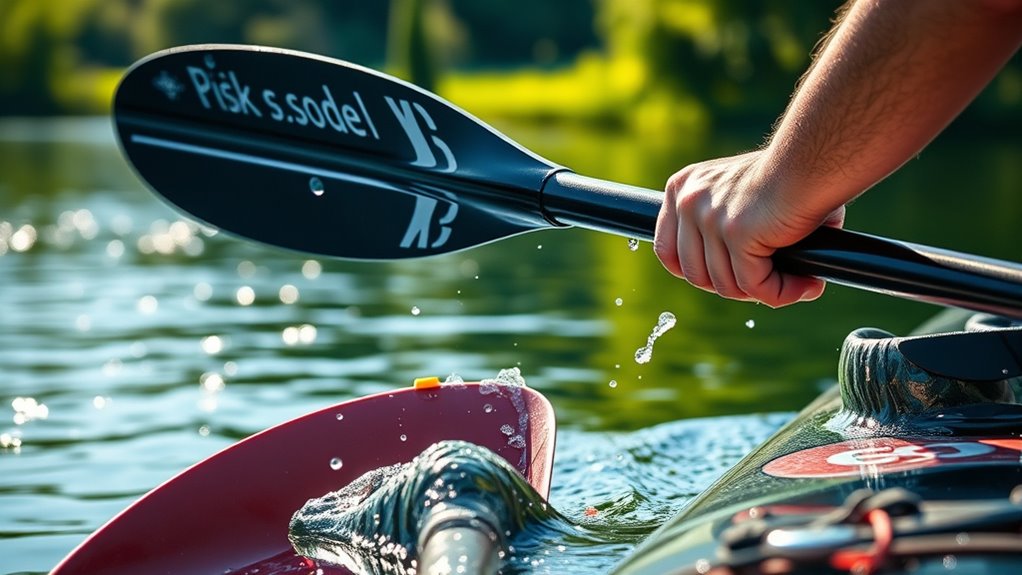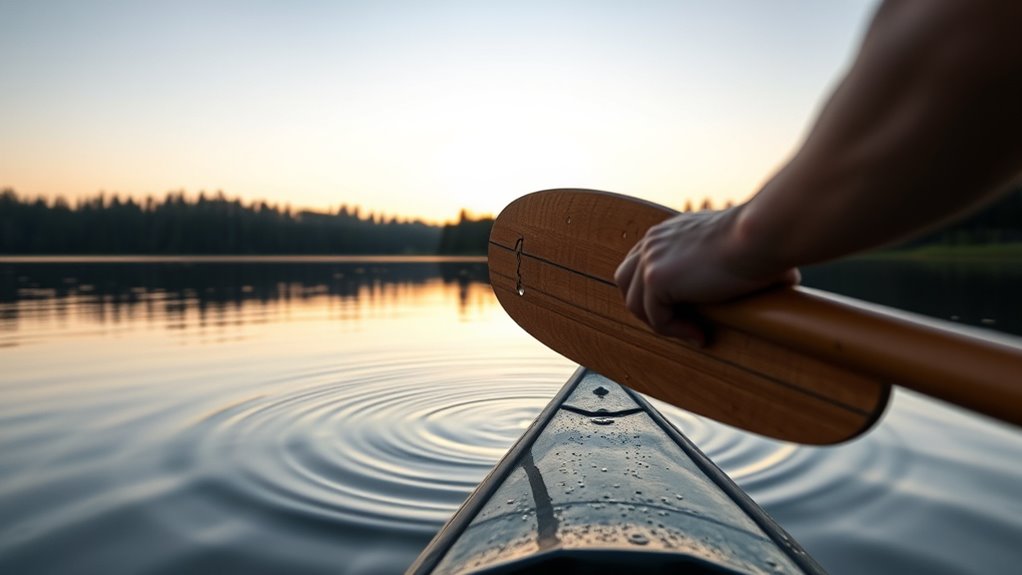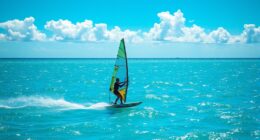Paddle strokes like the J-stroke and draw stroke are key to mastering your kayaking skills. The J-stroke helps you maintain a straight course, while the draw stroke lets you move sideways or make tight turns. To execute these strokes effectively, focus on your grip and paddle size. Regular practice will boost your confidence and control on the water. Want to enhance your paddling even more? There’s plenty more to discover about each stroke and technique.
Key Takeaways
- Mastering the J-stroke allows for straight navigation without frequent corrective strokes, enhancing paddling efficiency.
- The draw stroke enables lateral movement and tight turns, essential for maneuvering in limited spaces.
- Proper paddle selection based on kayak width and paddler height is crucial for effective paddling.
- Regular practice of both strokes builds confidence and improves overall control on the water.
- Maintaining your paddle and practicing proper technique extends its lifespan and enhances the kayaking experience.

Have you ever wondered how the right paddle strokes can enhance your kayaking experience? Mastering effective paddle strokes, like the J-stroke and draw stroke, can make a world of difference in your performance and enjoyment on the water. Each stroke serves a unique purpose, helping you navigate efficiently and maintain control. By focusing on these techniques, you’ll not only improve your skills but also build confidence in your paddling abilities.
Mastering paddle strokes like the J-stroke and draw stroke enhances your kayaking experience, boosting performance and control on the water.
When it comes to equipment selection, choosing the right paddle is vital. A paddle that suits your height, style, and the conditions you’re paddling in can markedly impact your effectiveness. For example, a longer paddle may be beneficial for wider kayaks, while a shorter paddle can provide better maneuverability for narrow craft. It’s essential to hold the paddle correctly and understand how your grip can influence your strokes.
The J-stroke is particularly useful for maintaining a straight course without excessive corrective strokes. To perform a J-stroke, start with your paddle fully submerged, pull through the water, and then flick the blade outward at the end of your stroke, creating a “J” shape. This action allows the blade to pivot, steering your kayak without having to change sides frequently. Practice this stroke until it feels natural; you’ll notice how smoothly your kayak glides forward.
On the other hand, the draw stroke comes into play when you need to move your kayak sideways or make tight turns. To execute a draw stroke, extend your paddle out to the side, immerse the blade, and pull it toward your kayak. This motion creates lateral movement, allowing you to reposition your craft effectively. Like with the J-stroke, practice is key. The more you refine these strokes, the better you’ll become at handling various situations on the water.
Don’t forget about paddle maintenance! Regularly check your paddle for any signs of wear or damage. Keeping it clean and free of debris will guarantee it performs at its best. A well-maintained paddle not only enhances your experience but also extends its lifespan.
Incorporating these strokes into your kayaking repertoire will elevate your skills and make your outings more enjoyable. So grab your paddle, hit the water, and embrace the journey of mastering these essential techniques!
Frequently Asked Questions
What Equipment Do I Need for Practicing Paddle Strokes?
To practice paddle strokes, you’ll need a suitable paddle that matches your height and skill level; the right paddle size is vital for effective technique. Make sure you have a comfortable paddle grip, as this will enhance your control and reduce fatigue. Additionally, consider wearing a personal flotation device for safety and choosing a stable kayak or canoe to help you focus on mastering those strokes without worrying about balance.
How Can I Improve My Paddle Stroke Technique?
Like a dancer perfecting their moves, you can improve your paddle stroke technique by focusing on stroke mechanics and grip. Start with a relaxed paddle grip, ensuring your hands are positioned correctly. Practice each stroke in slow motion, paying attention to your body’s alignment and the water’s resistance. Regularly engage in drills that emphasize different strokes, and don’t hesitate to ask for feedback. With dedication, you’ll notice significant improvements in no time!
Are There Specific Conditions for Practicing Paddle Strokes?
Yes, there are specific conditions for practicing paddle strokes. Ideally, you’ll want calm waters with minimal river currents and gentle wind conditions. This helps you focus on technique without battling external forces. Early mornings or late afternoons often offer the best conditions, as winds tend to be lighter. If you’re practicing in a river, aim for sections with slow flow to guarantee you can maintain control and refine your strokes effectively.
What Common Mistakes Should I Avoid During Paddle Strokes?
To avoid common mistakes during paddle strokes, focus on your grip and technique. An incorrect grip can lead to inefficient strokes and fatigue. Don’t rush your technique; take your time to make certain each stroke is deliberate and controlled. Pay attention to your body position and maintain a steady rhythm. Practice regularly, and you’ll improve your consistency and efficiency on the water. Remember, mastering these basics will enhance your overall paddling experience.
Can Paddle Strokes Be Learned Without Professional Instruction?
Yes, you can learn paddle strokes without professional instruction! Start with technique drills to build your skills. Focus on basic strokes and practice them regularly. Incorporate beginner tips like keeping your grip relaxed and maintaining a steady rhythm. Watching instructional videos can also help you visualize the movements. Don’t hesitate to seek feedback from experienced paddlers to refine your technique. With dedication, you’ll improve your paddle strokes in no time!
Conclusion
In the grand symphony of paddling, mastering the J-stroke and draw isn’t just a skill; it’s an art form that elevates you to the ranks of aquatic royalty. With each stroke, you’ll glide across the water like a majestic swan, turning heads and inspiring envy among fellow paddlers. Embrace these techniques, and you’ll not only conquer the waters but also transform into a veritable legend of the lake, leaving ripples of admiration in your wake.










